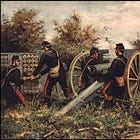The Slow Rise of the Machine Gun
The role played by other weapons
In the second half of 1970s, The Social History of the Machine Gun enjoyed enormous popularity. One reason, I think, was the title, which reassured persons of the genpop persuasion that any and all discussions of cyclic rates, gas ports, and mean-time between failures, would be confined to footnotes. Another was the manageable length of the work, which weighed in at less than two hundred pages. Finally, the author refrained from including the sort of information that might have complicated the main narrative of the work, a tale in which tech-savvy avatars of progress waged a long struggle against (but eventually triumphed over) the Dead Hand of the Past.
The melodrama at the heart of The Social History would have lost much of its poignancy had the author discussed the many other new weapons that armies adopted during the wilderness years of the machine gun. The first Maxim gun made it debut in 1885, at the start of a ten-year period in which the war ministries of the world would buy millions magazine-fed rifles, enormous quantities of smokeless propellants, and more steel-bodied shrapnel shells than I care to count. In the decade or so that followed, when automatic machine guns of various kinds found much favor with soldiers on the margins of military establishments, such devices proved less capable of delivering large numbers of little lead bullets than quick-firing field guns. Indeed, it was only in the years between the end of Russo-Japanese War (1905) and the start of the First World War (1914) that machine guns began to complement, rather than compete with, the other products of the armorer’s workshop.
‘White powder’, as the French called it, greatly enhanced the ease with which an automatic machine gun could be operated, maintained, and hid. Moreover, by permitting the use of smaller bullets, it made possible both a decrease in the size of the weapon itself and a reduction in the weight of a given number of rounds. At the same time, poudre blanc offered similar benefits to both rifles and field guns. (In the former case, bullets set in motion by smokeless powder traveled along flatter trajectories, thereby reducing the dependence of riflemen on precise range estimation. In the latter, higher muzzle velocities made the little lead balls released by shrapnel shells towards the end of their journeys much more destructive than precursors propelled by poudre noir.)
Towards the middle of the 1890s, moreover, the combination of fixed ammunition and improved breach mechanisms increased the speed with which field guns could be loaded. This, in turn, deprived early machine guns of one of the great advantages they had enjoyed over conventional artillery pieces: the ability to deliver continuous fire. (In the days when artillerists were obliged to load shells, powder bags, and primers in a series of separate steps, the interruptions in firing needed to perform such tasks gave nearby enemies opportunities to charge the guns.)
The on-carriage recoil-absorbing mechanisms that came into use at the dawn of the twentieth century enhanced the ability of field guns, not merely to subject subject distant groups of men and horses to heavy metal hurricanes, but also to engage large numbers of more proximate adversaries. (Though optimized for long range work, the shrapnel shells provided with quick-firing field guns could, when their fuzes were set to ‘zero’, perform the role previously played by canister rounds.)1
In 1898, Émile Rimailho, who had helped to design one of these recoil systems, wrote a memo exploring the second-order effects of the widespread use of quick-firing guns. Arguing that leaden hailstorms would lead to increased use of field fortifications, he concluded that armies, he concluded that armies would soon start looking for a reasonably mobile means of destroying trenches and other earthworks. In particular, he proposed that the French Army ought to adopt a quick-firing heavy field howitzer capable of firing shells that weighed in at 40 kilograms (88 pounds) or so.
In the fifteen years that followed, a number of armies adopted weapons of this sort. At the same time, many took measures to update older howitzers that had initially been acquired for sedentary employment, whether as part of the defensive armament of a fortress or a siege train. During the first year of trench warfare on the Western Front, the ease with which these artillery pieces could tear holes in linear defenses convinced defenders to adopt irregular dispositions. This, in turn, made available a great positions well suited to machine guns, places that allowed them to hide from hostile eyes, enjoy a degree of protection from ordnance of the lighter sort, and deliver fire of particularly effective types.2
For Further Reading:
To Support, Subscribe, or Share:
The use of shrapnel shells in this way led to the expression déboucher à zero [‘set the fuze to zero’], which French people of a certain generation used to remark upon the imminent arrival of a crisis of some sort.
For short, but well-illustrated, descriptions of battles of this sort, see the “tactics” sections of the two books about the British Expeditionary Force I wrote for Osprey.









C&Rsenal on the Youtubes.
https://www.youtube.com/channel/UClq1dvO44aNovUUy0SiSDOQ/videos
The French were often on the cutting edge, and becoming invested in early ideas only to fall behind. This plays out with Machine Guns.